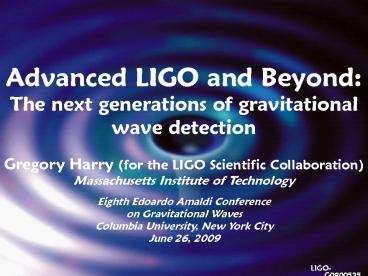Advanced LIGO and Beyond: The next generations of gravitational wave detection - PowerPoint PPT Presentation
1 / 13
Title: Advanced LIGO and Beyond: The next generations of gravitational wave detection
1
Advanced LIGO and BeyondThe next generations of
gravitational wave detection
Gregory Harry (for the LIGO Scientific
Collaboration) Massachusetts Institute of
Technology Eighth Edoardo Amaldi Conference on
Gravitational Waves Columbia University, New York
City June 26, 2009
- LIGO-G0900535
2
Advanced LIGO Overview
- Designed to have 10X sensitivity of initial LIGO
- 1000X in rate
- Higher bandwidth
- Sensitive down to 10 Hz
- Install at existing sites
Advanced LIGO Astronomical Reach
- Binary neutron star inspiral range 200 Mpc
- Beyond detection, do gravitational astronomy
LIGO Sites
3
Advanced LIGO Scope and Schedule
- Reuse vacuum system and buildings
- Replace nearly all of the initial LIGO detectors
- 3 interferometers
- All 4 km long
- Lengthen current 2 km at Hanford
- Likely identical, possibly one narrowband
Advanced LIGO Vacuum Chambers
- Funded in April 2008
- All subsystems in procurement/ fabrication end of
2009 - Begin installation at one site in 2011, other in
2012 - Finish installation 2013-2014
Advanced LIGO Schedule
4
Advanced LIGO Sensitivity
- RMS Strain (100 Hz BW)
- Requirement 10-22
- Goal 3 10-23
- Duty Cycle
- 75 triple coincidence
- Sensitivity Limitations
- 10-40 Hz Radiation pressure/Suspension thermal
noise/Gravity gradient - 40-200 Hz Coating thermal noise
- gt 200 Hz Shot noise
5
Astrophysics
- Inspirals
- Neutron Stars 40/yr
- 10 M? Black Holes 30/yr
- Neutron Star-Black Hole 10/yr
- Stochastic Gravitational Wave Background W
10-9 in 3 months
Inspiralling Neutron Stars
- Explore Low Mass X-ray Binaries around 300 Hz
- Possible to tune detector for different sources
- Multimessenger astronomy
- Gamma ray bursts
- Neutrinos from supernova
Crab Pulsar Nebula
6
Seismic Isolation
BSC Isolation Design
- Two related designs
- BSC for tests masses and beamsplitters
- HAM for supporting optics
- 3 stages of 6 degrees of freedom
- 2 active stages
- Hydraulic external stage
- Prototyping
- BSC in LASTI at MIT
- HAM in enhanced LIGO
- Fabrication
- HAM October 2009
- BSC July 2010
7
Suspensions
Quadruple Pendulum
- Based on GEO 600 design
- British groups lead for Advanced LIGO
- Quadruple pendulums for test masses and
beamsplitters triples for others - Two chains test mass and reaction mass
- Maraging steel blades for vertical isolation
- Monolithic silica last stage
- Dumbbell fibers (not ribbons)
- Ears silicate bonded to optic
- Fibers welded to ears
- Full testing in LASTI at MIT
Suspension Test at LASTI
Welded Fiber-Ear
8
Optics
Test Mass Blank
- 40 kg silica substrates for test masses
- Titania doped tantala/silica coatings
- Improved absorption and thermal noise
- Design optimized, lower thermal noise
- Prototyped at Caltech
- Dichroic at 1064 and 532 nm
- Thermal compensation
- Applied to reaction mass
- Ring heaters
- Projected 10 mm laser
- Prototyping in enhanced LIGO
- gt90 of substrate blanks received at Caltech
Coating Thermal Noise Data
9
Lasers
- German Albert Einstein Institute lead
- Non-planer ring oscillator (NPRO)
- NdYAG 1064 nm
- 180 W after 3 gain stages
Amplification Stages
- First two stages (30 W) prototyping in enhanced
LIGO - Full power engineering prototype at AEI
- Squeezed light possible as enhancement to
Advanced LIGO
Engineering Prototype
10
Systems
Different Tunings
- Homodyne (DC) readout
- Prototyping in enhanced LIGO
- Requires output mode cleaner
- Secondary, green interferometer
- Lock acquisition
- Arm length stabilization
- Electrostatic drive to control test mass
- High optical power
- Finesse of 450
- Concerns about parametric instabilities
- Signal recycling cavity
- Allows for tuning of quantum noise
- Baseline is broadband
Enhanced LIGO Output Mode Cleaner
Electrostatic Drive
11
Sensitivity Limitations
- Gravity gradients
- Suspension thermal noise
- Mirror thermal noise
- Coating Brownian and Thermo-optic
- Substrate Silica
- Quantum noise
- Radiation pressure
- Shot noise
- Non-Gaussian noise
- Important for Burst/Inspiral searches
Initial LIGO Non-Gaussian Glitches
12
3rd Generation Solutions
- Seismic and Gravity Gradient
- Underground
- Noise subtraction
- Testing at Homestake mine
- Quantum Noise
- High power
- Diffractive optics
- Squeezed light
Homestake Mine 1889
- Suspension and Mirror Thermal Noise
- Improved materials
- Coating, substrate, suspension
- Sapphire, silicon
- Cryogenics
- Displacement noise free interferometers
Diffractive Beamsplitter
- Coating Thermal Noise
- Beam shaping
- Change wavelength
- Shorter or 1.55 micron
- Khalili cavities, corner reflectors
Laguerre-Gauss Mode 33
40 kg sapphire optic
13
Conclusions
- Advanced LIGO in progress
- Procuring and fabricating parts
- Installation begins in 2011
- Significant increase in sensitivity
- Likely detections of inspirals, bursts
- Possibility of stochastic and pulsars
- Major subsystems designed, tested, and in
production - Sensitivity limited by laser power, materials,
environment, etc - Many directions for improved 3rd generation
- Need active research now































